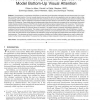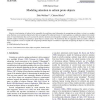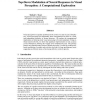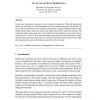TVCG
2008
14 years 9 days ago
2008
Scatterplots remain one of the most popular and widely-used visual representations for multidimensional data due to their simplicity, familiarity and visual clarity, even if they l...
TVCG
2008
14 years 9 days ago
2008
Abstract--Providing appropriate methods to facilitate the analysis of time-oriented data is a key issue in many application domains. In this paper, we focus on the unique role of t...
JAIR
2007
14 years 10 days ago
2007
In this paper we present a general, flexible framework for learning mappings from images to actions by interacting with the environment. The basic idea is to introduce a feature-...
IJON
2007
14 years 10 days ago
2007
In the real world, visual information is selected over time as well as space, when we prioritise new stimuli for attention. Watson and Humphreys [Visual marking: prioritising sele...
RAS
2006
14 years 10 days ago
2006
This paper presents the design of a stable non-linear control system for the remote visual tracking of cellular robots. The robot is controlled through visual feedback based on th...
PAMI
2006
14 years 11 days ago
2006
Visual attention is a mechanism which filters out redundant visual information and detects the most relevant parts of our visual field. Automatic determination of the most visually...
NN
2006
Springer
14 years 11 days ago
2006
Springer
Selective visual attention is believed to be responsible for serializing visual information for recognizing one object at a time in a complex scene. But how can we attend to objec...
NC
2008
14 years 11 days ago
2008
Visual perception is typically performed in the context of a task or goal. Nonetheless, visual processing has traditionally been conceptualized in terms of a fixed, task-independe...
IJON
2006
14 years 12 days ago
2006
Visual areas in primates are known to have reciprocal connections. While the feedforward bottom-up processing of visual information has been studied extensively for decades, littl...
BC
2006
14 years 15 days ago
2006
The part of the primate visual cortex responsible for the recognition of objects is parcelled into about a dozen areas organized somewhat hierarchically (the region is called the v...




